The creation of happiness. About Lina Bo Bardi’s
drawing
Caterina Lisini
Fig.
1 - Lina Bo Bardi, “Camera
dell’architetto” lithograph.
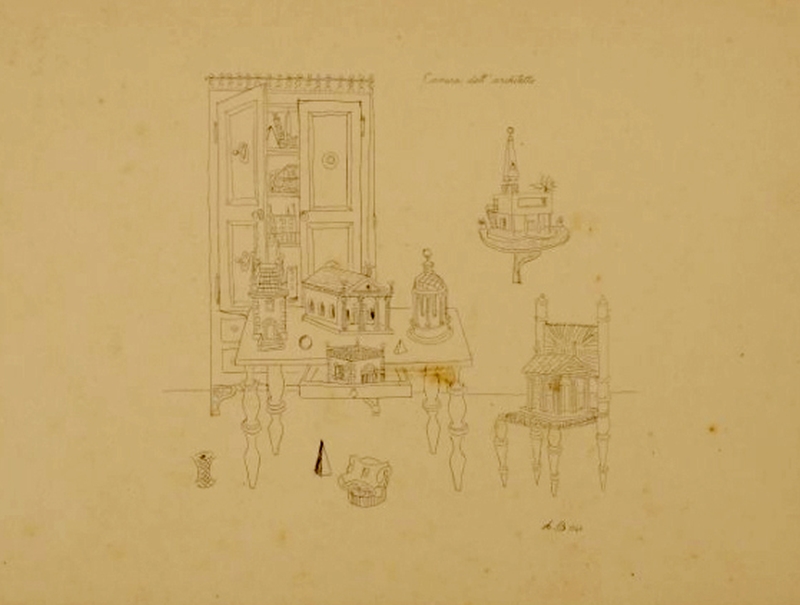
Fig.
2 - Lina Bo Bardi, MAMB Theater perspective.
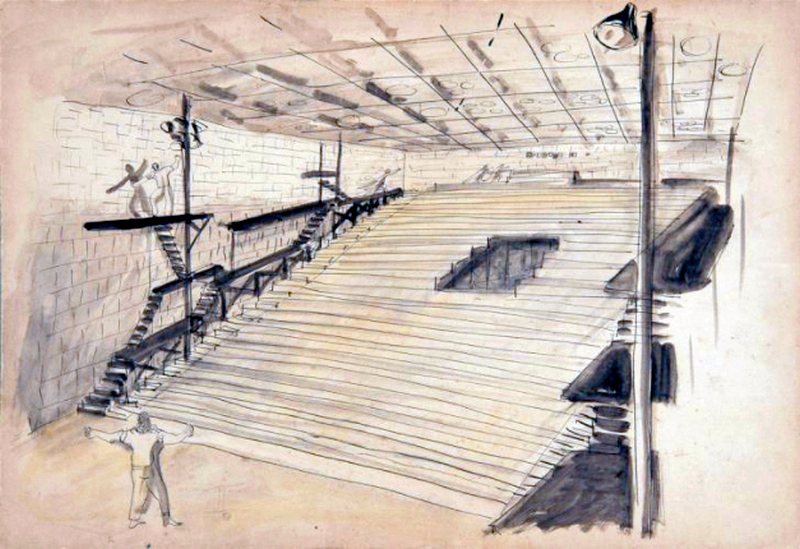
Fig.
3 - Lina Bo Bardi, study sketch for the stage costume for "Caligola".
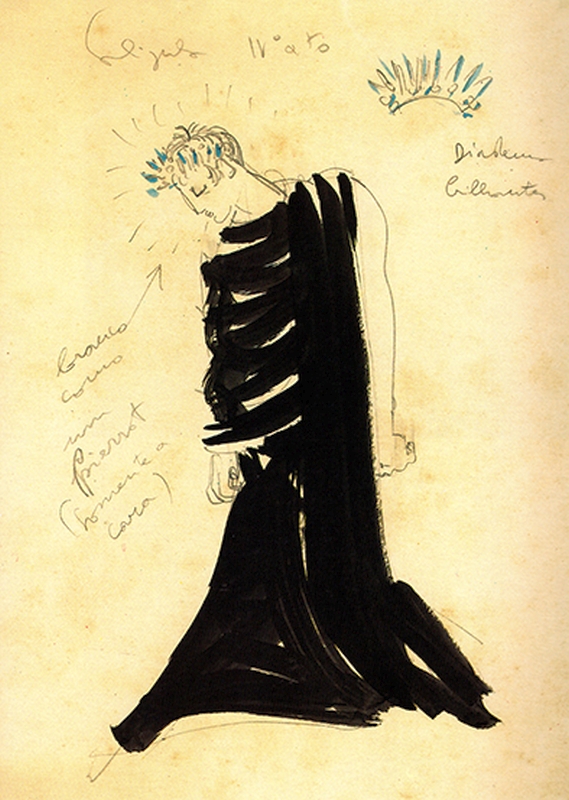
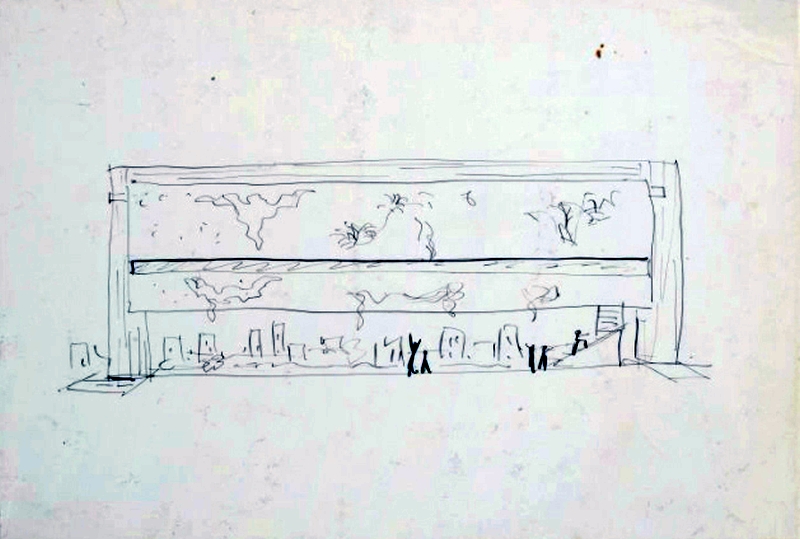
Fig.
4 - Lina Bo Bardi, MASP, study sketch for the facade.
Fig.
5 - Lina Bo Bardi, MASP, Belvedere perspective.
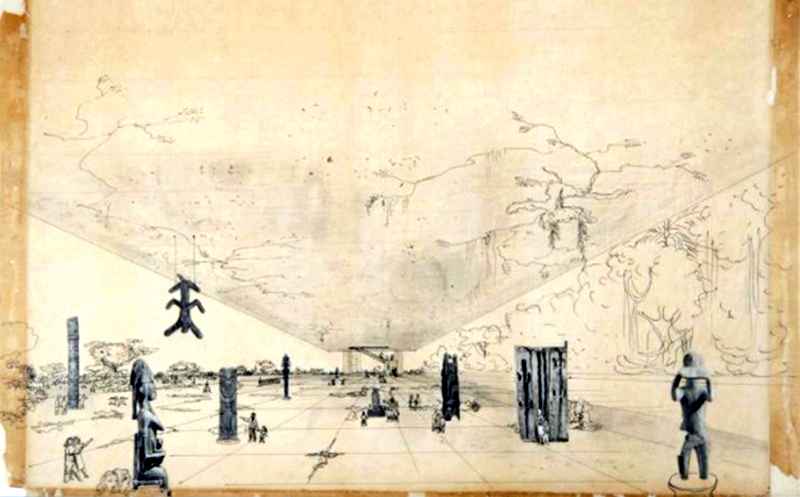
Fig.
6 - Lina Bo Bardi, SESC da Pompéia, plan study.
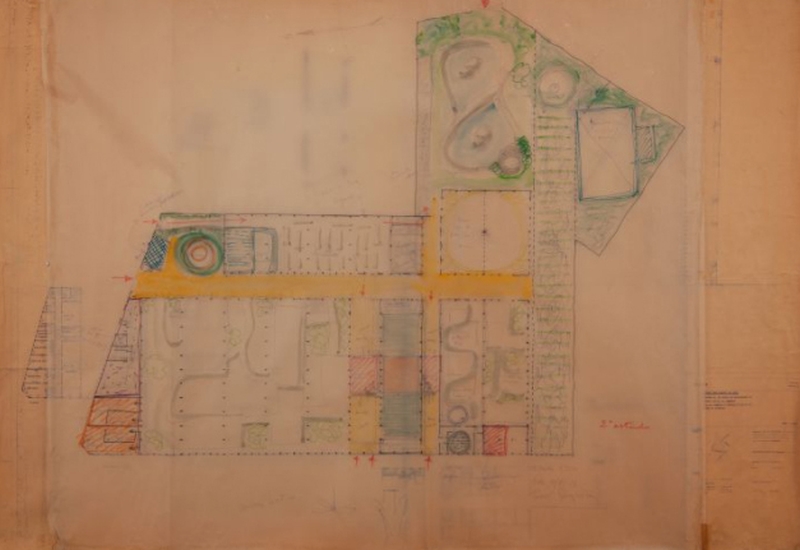
Fig.
7 - Lina Bo Bardi, SESC da Pompéia, Theater perspective.
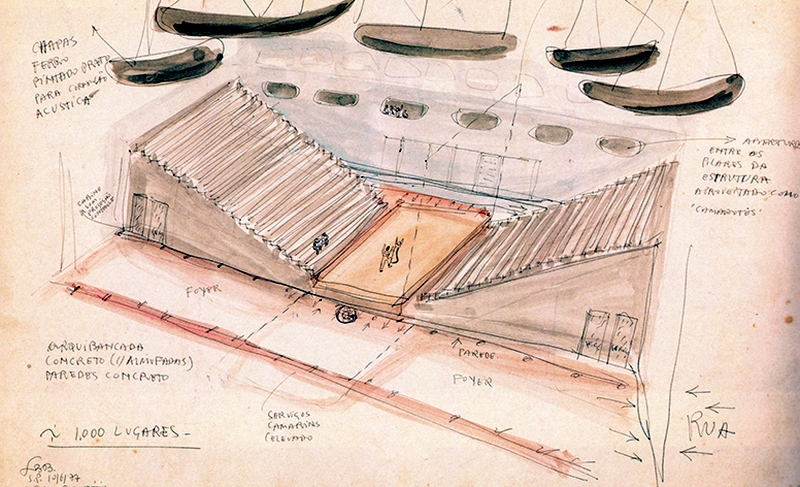
Fig.
8 - Lina Bo Bardi, SESC da Pompéia, study sketch for the
exhibition “Caipiras, capiaus: pau-a-pique”.
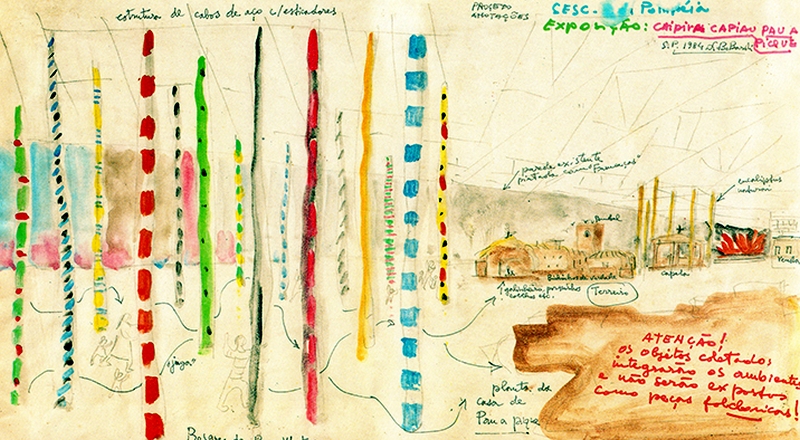
«I am not interested in writing», Lina Bo
Bardi told Francesco Tentori with sober frankness, «I am
fully aware that I can write well. My masters are Stendhal and
Majakovsky. The former taught me conciseness, when he declared that he
had learned to write from the officers of the French building cadastre
and the drafters of the articles of the Civil Code. The second taught
me rhythm instead, the fantasy of the real» (Tentori 2004, p.
151).
Also drawing, seems to have in Bo Bardi a similar dual soul,
which results in an extraordinarily multiformity of fertile
significances. Not only, or not so much, architectural drawings,
technical drawings that are functional to the project, to its execution
or to the worksite. But neither simply conceptual drawings, study
sketches, theoretical or expressive research drawings. Nor merely
imaginative, perceptive or travel drawings. Her drawings, whose traits
are often somewhat naïve, but at times meticulously precise
and constructive, show a great variety of techniques, from pencil
sketches, gouache, watercolour, ink drawing, and
collage, and covering remarkably wide-ranging themes and scales, which
include simple objects, furniture, jewellery, clothing, individual
residential houses, housing estates, public buildings of great scale
and complexity, as well as theatrical sets and museum and exhibition
set-ups and mountings, as a whole seem to be marked by the apparent,
manifest oxymoron: «the fantasy of the real».
In August of 1942, while the war was in full swing, the
magazine «Domus», then under an emergency editorial
staff which included Melchiorre Bega, Massimo Bontempelli and Giuseppe
Pagano, asked «a group of architects to describe
[…] with intimate confidence, the ideal design of the house
of their dreams», an elusive theme, almost involving
«drawing the impossible» (Redaz. Domus 1942, p.
312), to such an extent that it was interpreted, in the many
‘confessions’ that followed (Banfi, Belgiojoso,
Zanuso, Cattaneo, Diotallevi and Marescotti, Cocchia, Bianchetti and
Pea, Mollino, Pica, and others) as a symbolic rationalist house, as a
spiritual abstract house, as a subject of pure escapism, or else as an
autobiographical fantasy. Among the many drawings which exist from Lina
Bo Bardi’s years of education and training, first in Rome and
then in Milan, a lithograph from 1943 entitled Camera
dell’architetto seems like it could belong to this
gallery of reflections, offering the ironic and meditative
self-portrait of a period of her life which is about to conclude, and
already revealing in a nutshell a constant of her work, that is the
deep interweaving between drawing and autobiography. On an unremarkable
wall, a stylish closet with half-open doors serves as a bourgeois
backdrop to a small table with turned legs, next to which stands a
traditional stuffed chair: the whole domestic space is crowded with a
multitude of architectural models, mostly fictional, where a Classical
temple and a Renaissance temple, a fragment of a Palladian villa and
elements of historic dwellings meet in the foreground, while an Ionic
capital lies on the ground next to abstract geometric shapes.
Silhouettes of more distinctive architecture emerge from the closet:
obelisks, a mediaeval tower, the leaning tower of Pisa, the Colosseum,
and on one side, isolated above a small shelf, sits the model of a
modern architecture, connoted by pilotis and a fenȇtre
en longueur, partially concealing a tall obelisk. Rather
than an allegory, the continuous line of the drawing, as in an
illustration which does not wish to show off any technical virtuosity,
seems to represent a merry jumble which dissolves the multiple
references from the architect’s cultural baggage into a light
image, placing them all together, without hierarchies, in a sort of
silent dialogue. The mark of the cultural orientation derived from her
collaboration, together with Carlo Pagani, in Gio Ponti’s
publishing enterprises during the years 1940-1943 is quite evident. She
was a habitual presence in the last year of “Domus”
before the war and collaborated with continuity on
“Stile”, where she wrote about furniture, interior
architecture, and dealing as well with illustration and graphics,
including the design of several covers of the magazine. She also
collaborated occasionally on other magazines of Ponti’s
group, such as “Aria d’Italia”,
“Bellezza”, and “Vetrina e
negozio”. However, by 1943 new concerns had taken hold Bo
Bardi’s life which seem to seep out of the sense of
suspension of the drawing: as a result of the dramatic events of the
war, the impasse of rationalism and the emerging
debates within the groups of young architects, as well as the encounter
with Pietro Maria Bardi, and the growing need to assert her personal
convictions, the classical and idyllic limits of Gio Ponti’s milieu
became too narrow for her.
The urgency of reality and a new awareness burst in:
«I saw the world around me, Bo Bardi wrote some years later,
only as an immediate reality, and not as an abstract literary
exercise» (Carvalho Ferraz 1994, p. 10).
In this way a vision of architecture and of human works took
shape that was always tenaciously adherent to reality, a reality which
became imbued with hope and vitality since Bo Bardi landed in 1946 in
Rio de Janeiro, the city that represents the heart of the Brazilian
spirit, and to which she responded with a spontaneous and impetuous
creativity – «furious» according to
Semerani (2012, p. 8) – that is inseparable from the
experience of the body and physicality of the real, exercised in
shaping rigorous designs which were immediately contaminated with
festive and ironic evocations.
«Architecture as inhabited, human space, wrote Bo
Bardi in the early Fifties, is a powerful reality, accountable for the
behaviour of man, accountable even for his happiness. And in this sense
the Modern Movement continues» (Carvalho Ferraz 1994, p. 86).
Among the drawings made for the Museu de Arte Moderna da Bahia
(MAMB), which originated as part of her process of complex cultural
refounding matured during the years in Bahia and after her exploration
of the Brazilian Nordeste[1], those that stand out most are
the ones produced for the construction of the theatre «one of
the most direct means of cultural propaganda, since it contains all the
other arts» (Carvalho Ferraz 1994, p. 144). The perspective
of the audience cavea is sketched on one page,
with a few lines in pencil and ink, emphasised by the usual watercolour
brush strokes, to be built with simple wooden plank decks and enclosed
by a tangle of trellises and walkable stairs, which could also be used
for stage action, shaped almost as plant ramifications. There is no
formal adjectivation or superfluous scenography, as well as no
functional division between the space for the audience and technical
spaces, stage mechanisation is abolished and there is a continuity
between the theatrical representation and the audience, resulting from
the proximity of the improvised stage, with as backdrop the bareness of
the great structure of the Teatro Castro Alves, still partially
destroyed by the fire of 1958. A modern, simple, community theatre,
«poor yet violently emotional» (Carvalho Ferraz
1994, p. 144). Bo Bardi’s study sketches seem to appropriate
the profound simplification lesson[2] derived from her experience in
Bahia: in their traits there is no originality or gratuitous invention
but rather the constant search for the essential and an inclination for
‘poor’ and bare architecture, as well as for raw
and unfinished materials, which seems to spring directly from the
translation of the close link between human needs and their fulfilment,
between usefulness and beauty. In this case drawing for Bo Bardi is not
only a stage in her approach to the project, but becomes a social and
existential reflection, an expression, tout court,
of her poetics, that can be summarised, using her own words, in the
determined «anthropological research in the field of art
against aesthetic research» (Carvalho Ferraz 1994, p. 216).
And when her drawings become populated and enlivened with figures and
shapes, it is the reality of the Brazilian human environment and the
specific features of the target community that enter into action,
‘dirtying’ the sheet of paper with graftings and
contaminations. Thus in her work memory, the relationship with cultural
manifestations and popular traditions, is never nostalgic, a mere
revisiting of the past for its own sake, it is not even a critical act,
an inquiry into time in order to understand the art or the discipline
in question, it is rather a motion of continuous wonder, undertaken
almost through the eyes of a child, an amazement before a repository of
forms, a tangle of expressions and experiences, all human,
indispensable to nourish the imagery of her art.
There are numerous studies, distributed over a period of time
ranging from 1957 to 1966, for the solution of the facade of the great
gateway of the Museu de Arte de São Paulo (MASP), iconically
suspended at one end of Avenida Nove de Juhlo. The version dearest to
Bo Bardi, which she tenaciously explored for a long time, envisaged the
elevated body of the Museum as a single mighty concrete monolith, lit
from above, materially dense and completely blind, except for a long
horizontal slit at the level of the temporary exhibitions, and entirely
embedded with plant inlays, drawing an irregular pattern of tropical
vegetation emerging «among the interstices of the raw
concrete, as if from the cracks in the stones of an old
cathedral» (Lima 2021, p. 259). As part of that same series
there is an unusual perspective of the Belvedere, traced precisely
under the imposing frame of the museum and aligned with it, to the
extent that it seems to stretch almost infinitely, which depicts, among
the efflorescence of the vegetation, sketched in pencil, a collage of
great tribal sculptures freely distributed throughout the vast space
and surrounded by visitors, almost as if probing the vision of a new
society capable of imagining a continuous overlapping of archaic
artistic manifestations and contemporary creativity.
Bo Bardi draws what she is thinking about and designing, in
fact she thinks by drawing and at the same time thinks by looking at
the world. What guides her hand, as in any true artist, seems to be
«the four-eyed head», imagined by the contemporary
artist Tullio Pericoli, «with its double set of eyes, one on
the forehead and one in the brain», the material eyesight and
that of the intellect which cannot do without each other, in the same
way that «it is not possible to see without involving the
heart and the mind» (2021, pp. 43, 41). Even in her more
specifically architectural drawings there is rarely anything conceptual
about them, far from being polished, there is something immediate,
spontaneous and vital in them, a kind of continuous flow between art
and life, almost as if they had been made only for herself –
Bo Bardi confessed: «I work during the night, when everyone
else is sleeping […] and all around me there is
silence» (Dos Santos 1993, p. 17) –, for the
urgency of putting her thoughts on paper as they are being formed.
There is in Lina’s drawings (this is how she is
affectionately known, still today, almost everywhere throughout Latin
America) a conflict, or rather the fruitful co-presence of a rational
inclination, on the one hand, which is well suited to her Eurocentric
education, and a surrealist tendency, on the other, which blends with
her instinctive attachment to popular culture, to myth, to the
ancestral rites of the local tradition: that
«enchantment», which she said she felt immediately
after arriving in Rio, «a real, not metaphysical hope found
almost on a daily basis in the simplicity of the architectural
solutions, in human salutations, things that were unheard of for a
generation that arrived from far away» (Carvalho Ferraz 1994,
p. 12).
Surrealism seems to completely take over the drawings of the
Leisure Centre SESC Fábrica da Pompéia, carved
out of the industrial suburbs of São Paulo by converting an
old metal drum factory. They show, through the huge number of sketches
and tests, Bo Bardi’s extraordinary capacity to hold together
the very different scales of the project, from the high cement
‘towers’ of the sports facilities, to the minute
design of the furnishings, the staff uniforms and even of the
advertising indications. «As in any Surrealist research, from
Savinio to Picasso, Breton, Buñuel or Jarry, it is the
images and materials which generate the composition through which the
mechanic and the organic, the pure and the impure, desire and chance
traverse the boundaries that separate them» (Semerani and
Gallo 2012, p. 29). Yet in the case of Bo Bardi a hermeneutic capacity
is added: it is an attitude which draws and stages «the
imperceptible rustle of life», which in turn seems to relate
her artistic path to that of a writer such as Natalia Ginzburg, another
extraordinary 20th century female figure who was
her contemporary. «It is the pleasure of using the mind as
the bowels, of having the mind walk in darkness, the journey and the
vicissitudes of intellectual knowledge being nothing more than the
slightly blackened mirror which reflects what in those depths [...] is
dark yet still legible» (Garboli 1989, pp. 116, 106). For
both probably an entirely feminine capacity for inclusion and
appropriation of the world, that in the case of Bo Bardi seems to guide
the steady hand with which sketches her creations.
From the first draft plans a theatre, symbol of life and
participation, is placed at the cross-shaped intersection of the long
open-air public paths that branch out from the Centre. A meaningful
perspective sketch shows, in the elongated rectangle of the former
warehouse, the completed layout for a modern theatre with a central
stage made entirely in cement, with the monolithic block of the two
cavea like terraced stands facing each other and surrounded by linear
balconies overhead which offer additional space for the audience, with
views from above and to the side of the stage, all of which animated by
the sculptural presence of large steel plates, silver in colour, in the
way of Calder’s Mobiles, hanging from
above and performing acoustic functions. All around, in the warehouses
liberated from all interior partitions, the spaces for recreational and
cultural activities are located, such as the library, workshops,
reading and children’s play spaces, as well as rest and
exhibition areas and the vast lounge with the carvings recalling a
watercourse and the foguiera – the
great fireplace –: all places for social interaction
interconnected and interwoven by way of a sought-after
‘chancefulness’ which reflects the unpredictable
nature of life. All of Bo Bardi’s drawings, full of voices
and colours, seem to spread-out in thousands of rivulets of intense
creativity that find expression even in the furnishings, such as the
austere theatre seats, entirely in solid wood, not stuffed or
upholstered in velvet as in 18th century court
theatres or in accordance to contemporary comfort standards, but rather
devised for «giving back to the theatre its capacity for both
distancing and engaging». The drawings, even those more
properly architectural, are never aimed at presenting a work or a
creation, at presenting a professional proposal, but are rather
intended as research and knowledge tools. A festive atmosphere, an
ironic cheerfulness, continuously hovers above them, that is
inseparable in Bo Bardi from a form of understanding or wisdom about
life, and which seems to summarise her peculiar and unique creation of
happiness. «Todos juntos»,
Lina wishes the recipients of her Sesc Pompéia to be,
«young people, children, senior citizens, all united in the
pleasure of getting together, of dancing and singing» (Bo
Bardi 1992, p. 225).
Notes
[1]
Lina Bo Bardi went to Salvador de Bahia for the first time in February
1958. She returned in 1959 and remained there until August 1964, a few
months after the military coup d’état.
On these experience she published an article in 1967 entitled Cinco
anos entre os brancos (“Mirantes das artes
etc”, 6, November – December), later translated in Cinque
anni tra i bianchi (Carvalho Ferraz, 1994, pp. 161-162).
[2]
On the meaning of ‘simplification’ for Lina Bo
Bardi see her words in the writings Museu de Arte de
São Paulo and Mostra Nordest (Carvalho
Ferraz 1994, pp. 100 and 158).
References
BO BARDI L. (1953) – “Museo sulla sponda
dell’oceano”. Domus, 286, 15.
BO BARDI L. (1974) – “Sulla linguistica
architettonica”. L’Architettura, 226.
BO BARDI L. (1987) – “Centre
Socio-Culturel SESC Pompéia”.
L’Architecture d’Aujourd’hui, 251,
6-9.
BO BARDI L. (1992) – “Centro de Lazer SESC
“Fábrica da Pompéia, São
Paulo, Brazil, 1981-89”. Zodiac, 8, 224-229.
CARVALHO FERRAZ M., (edited by) (1994) – Lina
Bo Bardi. Charta-ILBPMB, Milan-São
Paulo.
CRICONIA A., (ed.) (2017) – Lina Bo
Bardi. Un’architettura tra Italia e Brasile.
Franco Angeli, Milan.
DE OLIVEIRA O. (2000) – “Lina Bo Bardi,
architetture senza età e senza tempo”. Casabella,
681, 36-55.
DOS SANTOS R. C. (1993) – “Lina Bo Bardi:
l’ultima lezione”, interview. Domus, 753,
17-24.
GALLO A. (edited by) (2004) – Lina Bo
Bardi architetto. Marsilio, Venice.
GARBOLI C. (1989) – Scritti servili.
Einaudi, Turin.
LIMA ZEULER R. M. DE A. (2019) – Lina Bo
Bardi, Drawings. Princeton University Press, New Jersey,
USA.
LIMA ZEULER R. M. DE A. (2021) – La dea
stanca. Vita di Lina Bo Bardi. Johan & Levi Editore,
Milan.
MAGNAGO LAMPUGNANI V. (1990) – “Centro
sociale e sportivo «Fabbrica Pompéia»,
San Paolo”. Domus, 717, 50-57.
PERICOLI T. (2021) – Arte a parte.
Adelphi, Milan.
PONTI G. (1953) – “Casa de
Vidro”. Domus, 279, 19-26.
REDAZ. DOMUS (1942) – “La casa e
l’ideale”. Domus, 176, 312.
SEMERANI L. AND GALLO A. (2012) – Lina Bo
Bardi. Il diritto al brutto e il SESC-Fàbrica da
Pompéia. Clean, Naples.
TENTORI F. (2004) – “Ricordo della Signora
Lina”. In: Gallo A., (ed.) – Lina Bo
Bardi architetto. Marsilio, Venice.







